- Publications:
- Newsletter:
- How-To Tutorials:
- Consumer Guides:
- Related:
Media Notice: Please read the Terms of Use for further details regarding reprint permissions.

Image by Robert Ubell
Publishers:
Accurate Building Inspectors ©
Division of Ubell Enterprises, Inc.
1860 Bath Avenue
Brooklyn, NY 11214
voice - [718] 265.8191
toll free voice - [800] 640.8285
fax - [718] 449.7190
Lawrence J. Ubell *
- President
Alvin Ubell **
- Founder Vice President
Matthew Barnett *
- Senior Inspector
Estelle R. Ubell
- Sec. Treasurer
Emily Hoffman
- Editor & Broadcaster, WNYC & WQXR
Contributors:
Robert H. Wolff, Esq. of Rosenberg,
Minc, Falkoff
& Wolff, LLP
Ari Saltz, of GFI Mortgage Bankers, Inc.
Stanley Turkel, MHS, ISHC
Bertrum Herman, Esq.
Howard Kurtzberg, Esq.
* Licensed In: New York, New Jersey
** Licensed in: NJ
Contribute:
If there is a subject that you would like to see discussed or an article that you would like to contribute to be featured
in The Gotham City Inspector©, please forward your comments to:
Letters to the Editor
Media Notice: The publishers, grant reprint permission of all articles in the Gotham City Inspector© Newsletter, provided that appropriate written recognition is given to the authors and “The Gotham City Inspector©”. For online reprints, please also include an HTML link to The Gotham City Inspector©: www.accuratebuilding.com

The Gotham City Inspector©
Fall 2004, Vol. 2, No. 2

![]() Gotham City Inspector Newsletter
Gotham City Inspector Newsletter
HEADLINES
- • Get The Lead (Pb) #82 Out
- • Mold & More Mold
- • Save Energy & Money With Cleanliness
- • Lose The Door Bell Blues
- • Understanding Homeowner's Insurance
Living In New York
Get the Lead (Pb) #82 Out Of Housing!
On August 2, 2004, a new lead paint hazard reduction law went into effect in New York City.
“Local Law 1” is comprehensive legislation concerning the prevention of childhood lead poisoning through the remediation of lead paint hazards in housing and day care facilities.
“Local law 1” has banned lead paint since 1960 and by federal law since 1978, but because over half of New York City's housing stock was built before 1947, lead paint remains a concern.
The newest version of “Local Law 1” (which repeals the former lead law, Local Law #38 of 1999) contains many new obligations for landlords of multiple dwellings constructed prior to 1960 and in buildings constructed between 1960 and 1978 where the owner knows that lead-based paint was used.
Some of these new property owner responsibilities are:
» Inquiring on an annual basis if children under seven years old are or will be living in the unit. Owners must give notice about their responsibilities with each lease and provide a pamphlet informing occupants about lead. Owners must physically inspect units whose occupants do not respond to determine if there is a child under seven living there.
» In the units affected, owners must investigate the apartment as well as common areas in the property to find peeling paint, chewable surfaces, deteriorated sub-surfaces, and friction and impact surfaces. This must be done at least once a year, or more often if the owner knows about a condition that may cause a lead hazard, or if the occupant complains about such a condition.
» Remediation of lead hazards both in the unit where a child under seven lives and in common areas of buildings with these units. It must be done using safe work practices and trained workers.
» Making apartments lead safe on turnover.
The Gotham City Inspector says:
This new law is not about lead, but about lead hazards. Lead paint that's been painted over by latex is not a hazard … unless the latex wears away. When a door or window is repeatedly opened and closed, the friction can release lead dust and that's a hazard.
Children are particularly susceptible to lead because they metabolize it quicker than adults. Significant exposure can affect the brain, nerves and kidneys and result in lead induced anemia. In some cases, the damage can mean death.
Our advice is to be proactive. Start getting lead assessors and inspectors involved before there are violations. If necessary, you can make the changes on the property and roll them over as capital improvements that can be passed on to your tenant.
Lead doesn't sit in the air like asbestos. It's heavy. It falls to the floor where children often sit and play. Even if you have lead in your home, the best way to avoid a problem is through cleanliness: mop the floors, clean, vacuum.
Compliance with the new law will be difficult. Already, there have been challenges by landlords and developers (including one recently dismissed by the court), who say that the law will require them to take steps that will be prohibitively expensive.
Mayor Bloomberg has argued that the law will cost the city millions of dollars and will reduce the supply of affordable housing and that it is not the most effective way to combat the problem of lead paint.
Only time will tell if the law will be enforceable and effective and what the ramifications will be.
House Proud
Break the Mold … Before It Breaks You!
It's slimy and sticky … black, brown or orange. It lives indoors or out. There are hundreds of varieties…some knobby, some hairy, some beneficial, some toxic. Half a million will fit on a penny.
Mold is microscopic but mighty. Attorneys are reporting more and more lawsuits from people who say it severely impaired their health. Multimillion dollar judgments have been awarded against homebuilders and insurance companies who haven't taken care of it. Mold damages your home, pocketbook and health.
To grow, mold needs moisture, an organic material for food (like wood), and a space with poor ventilation all conditions commonly found in homes.
Moisture accumulates in a wall cavity, crawl space or basement if there are roof and plumbing leaks, improper grading, a lack of gutters, or cracks in the foundation.
Mold likes a young home those built within the last 30 years have higher insulation, less ventilation … and potentially more mold.
Mold can grow anytime, but a wet Winter could mean a fuzzy Spring. So, “break the mold” now. Here's a 12 Step Program to Protect Your Health and Your Investment Against Mold:
- Fix leaky plumbing, roof leaks or other sources of water.
- Wash mold off hard surfaces and dry completely. Replace affected absorbent materials, such as ceiling tiles and carpet.
- Keep air conditioner, refrigerator and dehumidifier drip pans clean and dry.
- Use exhaust fans or open windows in kitchens and bathrooms when showering, cooking or using the dishwasher.
- Place vents for clothes dryers and bathroom exhaust fans outside the home.
- Remove and replace flooded carpets and drywall.
- Maintain an indoor relative humidity of between 30-50%. Measure the humidity levels with a hygrometer, found at most local hardware stores.
- Clean bathrooms with mold killing products.
- When painting the home, add mold inhibitors to paint.
- Do not carpet bathrooms.
- The level of ventilation in the attic and crawl space should be evaluated, and improved as needed.
- If a problem persists, have the condition evaluated by an expert in mold/moisture intrusion.
One final twist on the mold story: a former police officer in Florida thinks man's best friend could be mold's worst enemy. He's got a canine academy where he trains dogs to sniff out mold in buildings. So far, over 50 dogs have graduated. In the race against mold, he wins by a nose!
Inspector's Diary

“Save Energy & Money With Cleanliness”
Keeping Out The Cold … Cleanliness is Next To Godliness
Don't wait until the cold weather to start thinking about your heating system. Taking steps now could save you time, money and keep you safe and warm this coming
Winter:
» Clean out the combustion chamber. If it's dirty, sulfur dioxide could seep into your house. That is not only unhealthy it's dangerous.
» If you're heating with gas, make sure the pilot light is not carbonized and that it's clean. In an oil burner, make sure the filters are replaced and that the controls and safety devices are clean and functioning properly. You should clean oil burners a minimum of once a year and gas burners once every two years.
» Below ground oil tanks also have to be checked for leakage. The oil suppliers usually have maintenance contracts on these tanks. In many instances, the oil supplier will also clean the boiler.
» Make sure all chimneys are clean … there could be a leftover nest from the summer. A blockage could mean smoke damage and unhealthy fumes inside your home.
» Don't use your utility room as a storage closet. A heating room is no place for clothes, cleaning supplies and chemicals that are flammable. There's a theme here: Cleanliness is not only next to Godliness … it's also a key to health, safety and savings when it comes to heating your home.
Lose the Door Bell Blues
A Recipe for Home Repair:
Fix That Broken Doorbell Button
When it's time for “Trick or Treat,” don't be stuck with lots of leftover candy because of a broken door-bell button. Here's how to fix it:
- Remove the old doorbell button with a screwdriver.
- Unscrew the two connecting wires and straighten end (Fig. A)
- Clean away dirt.
- If wires are broken, strip both back with wire stripper inch.
- If wires are frayed, tape frayed areas with friction tape (Fig. A)
- With long-nosed pliers, form hooks of wire ends (Fig. B)
- Unscrew terminal screws on new doorbell but do not remove (Fig. C)
- Place hooks around terminal screws in clockwise direction and tighten screws in clock wise direction, making sure wires do not touch (Fig. D)
- Push wires back into wall hole.
- Place new doorbell button against doorframe where old button was removed.
- With awl, punch holes in door through screw holes in the doorbell button plate. (Fig. A)
- Insert screws and drive into place.
- Press button, and bell, buzzer or chimes will sound.
Attorney's Corner:
What Is Homeowner's Insurance?
by Contributing Editor Bertram Herman, Esq.
Homeowners' Insurance is a form of personal insurance that came into being about fifty years ago. Owners of small homes (usually single to three-family dwellings) used to have a choice of separate types of insurance.
The first policy was for Fire and Extended Coverage or “EC” In addition to fire losses, it also afforded protection for damage to a home (or in some cases the contents of a home) resulting from windstorm, hale storm, hurricanes and other factors.
Another type of coverage was for Theft Losses both at and away from the premises.
The final type of policy was called Comprehensive Personal Liability Insurance. This would insure against legal liability resulting from defects in the premises and when the insured and relatives who live in the household accidentally caused injuries to people on and off the premises.
In recent years, the insurance industry decided to package these various policies into one policy known as the homeowner's policy and sell it for a premium that costs less than when they were purchased separately.
Many insurers offer homeowners' policies at more than one level of benefits and charge premiums accordingly.
In the event of a fire or EC loss, many insurers will provide Guaranteed Replacement Coverage for the home that enables the insured to rebuild. In cases where the fire or loss makes the premises uninhabitable during construction, this policy will pay to put up the residents in a hotel. You should check to see if your policy provides this option and if the expenses provided are adequate.
Many of the fire and EC policies insuring losses to the contents are written on an actual cash value basis, as opposed to the replacement value. For example, a large 20-year old television might cost over a thousand dollars to replace but its actual cash value is only one hundred dollars, so that's all you'll get. It's best to have the contents coverage be written as a replacement cost policy.
Theft insurance covers items that are stolen from the premises itself. Off premises theft is generally available too. It's best to try to obtain off premises theft coverage that does not require evidence of forced entry, such as a broken window of a car, since many cars these days can be opened by keyless entry.
Regarding liability insurance, the common perception is that each time an incident occurs, the person is insured up to the amount of the insurance in the policy. You should review your policy to see if multiple losses of a similar nature are restricted to a single policy limit, even when they occur during different years, or if the benefit could be exhausted in one year. If your policy contains such a limitation, you may wish to find a new insurer where such provisions do not apply.
One final note on policy deductibles: There's a new type called the hurricane deductible. This deductible ranges anywhere from 2%–5% of the fire and EC policy limit on the building itself, depending upon the policy. Therefore, when a loss results from a hurricane or other windstorm and the building is insured for $500,000, with a 5% hurricane deductible, the deductible will be $25,000. Policies generally say that when the wind velocity reaches a certain point at a particular weather station when the loss occurs, the hurricane deductible applies. It's a good idea to check if the weather station used to trigger this deductible is located where there are higher wind velocities than the weather station closest to your home.
I am not recommending any particular insurers. Contact
the New York State Insurance Department for their list of
the 10–best & 10–worst insurers in the State at:
http://www.ins.state.ny.us/hmonindx.htm
About the Author:
Mr. Herman has been specializing in cases involving insurance property and liability coverage for both claimants and insurers for over 40 years. His office is located in Mount Kisco, New York.
Public Service Announcement
Exercise Your Civic Muscles:
Remember To Vote!
Politics affects almost everything from driving to shopping, from the television we watch, to the food we eat, our home, work and school, our lives now and our children's future. That's why elections are so important. It's our chance to affect politics and shape the decisions that will shape our lives.
This November, exercise your right and your duty as a U.S. citizen.
Make your opinion count. Register & Vote! Convince your friends and neighbors to vote!
“Helpful ideas at your finger tips!”
If you would like to receive the The Gotham City Inspector© newsletter, please email
your request and include your name, business name, business telephone and address.
E-mail: info@accuratebuilding.nyc






